Also known as the “Silver State,” Nevada is a stunning state which has a diverse range of habitats. Nevada is home to many different ecosystems with huge mountain ranges and vast river basins. Despite this, it is perhaps better known for its desert regions, including the Mojave Desert. However, no matter where they are in the state, the animals within are as diverse as their living places.
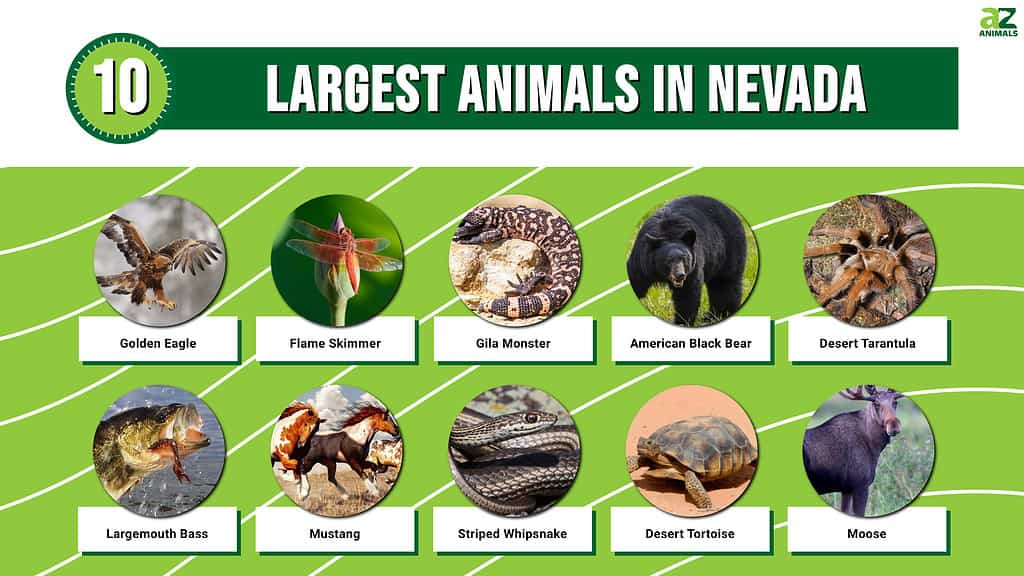
So join us as we discover the 10 largest animals in Nevada and where you’ll find them!
Golden Eagle

Golden eagles are huge birds with a wingspan of up to 7.5 feet.
©Vladimir Kogan Michael/Shutterstock.com
One of the largest birds in Nevada is undoubtedly the golden eagle, with a massive wingspan of 5.9 to 7.5 feet. These stunning birds are typically dark brown with golden brown heads and necks. Golden eagles are adaptable birds but generally prefer to live in fairly open habitats such as grassland, hillsides, and mountain regions. They are common right across Nevada and live in any such suitable habitats. They also have some of the largest territories of any bird, and their home range can be as large as 77 square miles. Golden eagles are usually diurnal and prey predominantly on small mammals, birds, reptiles, and fish.
Flame Skimmer

The flame skimmer is a popular dragonfly native to western North America.
©Sarah Argo/Shutterstock.com
With their bright red or orange coloration, flame skimmers are some of the most stunning insects in Nevada. These dragonflies have long wings and long bodies, usually between 2 and 3 inches. As nymphs, they feed on aquatic insects, while as adults, they favor ants, flies, and moths – many of which are caught on the wing. Flame skimmers mainly live around ponds and streams, although they can sometimes be found in gardens. In Nevada, they are most often seen around Las Vegas.
Gila Monster
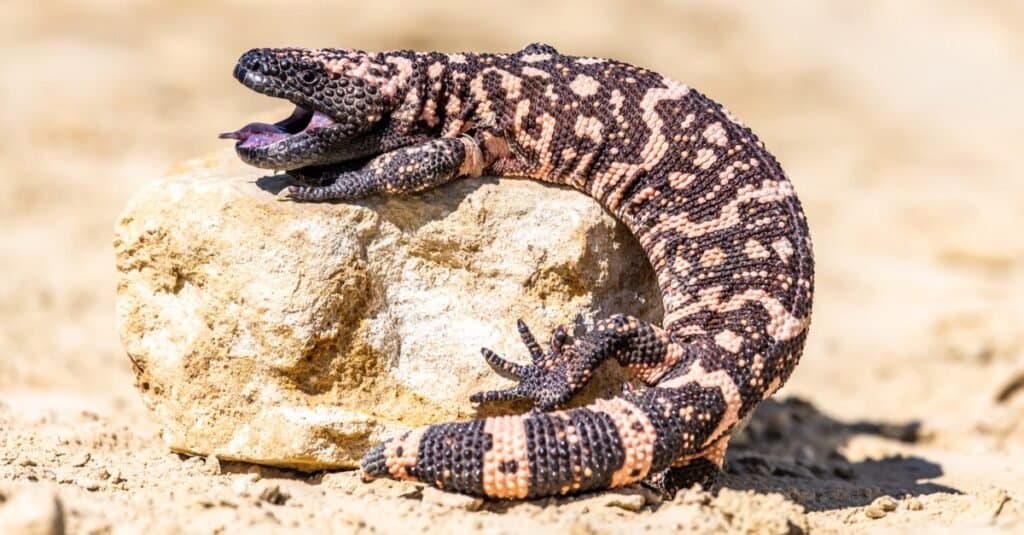
Gila monsters are large, vibrant-colored reptiles.
©Vaclav Sebek/Shutterstock.com
One of the biggest reptiles in Nevada is the Gila monster, a venomous lizard. Gila monsters can reach 22 inches long and have black bodies with vibrant pink or orange markings. They live in deserts and grassland, and in Nevada, they can be found in the Mojave Desert. Gila monsters have a varied diet and prey on small mammals such as rodents, birds, snakes, tortoises, insects, and other lizards. Their venom is produced in modified salivary glands and is rarely fatal for healthy adults. Despite posing little threat, they have a notorious reputation which often leads to them being unnecessarily killed. Common myths about them include tales that they spit venom and have toxic breath.
American Black Bear

Black bears are the only bear native to Nevada and weigh up to 660 pounds.
©BGSmith/Shutterstock.com
Despite being the smallest North American bear, American black bears are easily one of the largest animals in Nevada – as well as being the only naturally occurring bear in the state. American black bears weigh between 90 and 660 pounds, with males being larger than females. They typically prefer habitats with plenty of thick vegetation, such as woodlands and mountainous regions. They generally occur in the Carson Range near the Lake Tahoe Basin in Nevada, although they also live in the Pine Nut, Sweetwater, Wassuk, and Jarbidge Mountains. American black bears are territorial animals and often mark trees with teeth and claws. They are omnivorous and eat a variety of insects, honey, fish, and plant material.
Desert Tarantula

Desert tarantulas are huge spiders that typically have a 4-inch leg span.
©Ryan M. Bolton/Shutterstock.com
As their name suggests, desert tarantulas favor desert regions. They are fairly widespread across Nevada, but incredibly the town of Gabbs is probably one of the best places to see them. This is because thousands leave their burrows every year and go marching through the town in search of a mate. Considering that these spiders have a leg span of around 4 inches and large, hairy bodies, it makes for a pretty terrifying sight. However, despite their fearsome size, desert tarantulas are not particularly dangerous to humans, with their bite being likened to a little worse than a bee sting.
Largemouth Bass

Largemouth bass has huge, gaping mouths and can weigh up to 25 pounds.
©iStock.com/stammphoto
Also known as the widemouth bass, largemouth bass are large freshwater gamefish. They are green or greenish-gray in color with black blotches in a line along their flank. The upper jaw of their mouth extends beyond their eye. Largemouth bass can reach up to 29.5 inches long and weigh up to 25 pounds. The largest caught in Nevada was 26 inches long and weighed 12 pounds. Lake Mead and Lake Mohave are the best places to find largemouth bass in Nevada. Largemouth bass are carnivorous fish and prey on smaller fish, frogs, snakes, birds, and small mammals.
Mustang
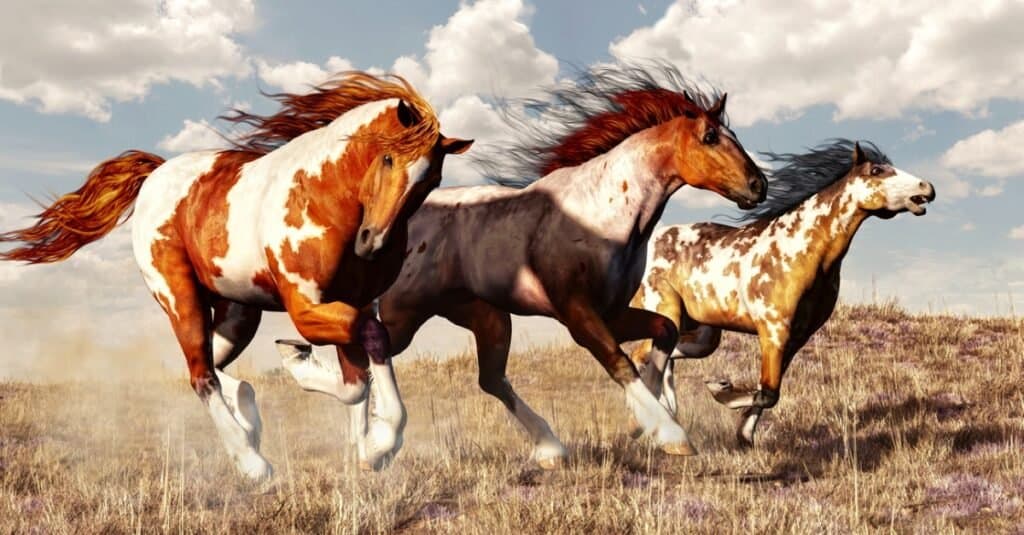
Around 60% of all wild horses in the United States occur in Nevada.
©iStock.com/Daniel Eskridge
As the perfect image of wild and free, mustangs are some of the most stunning animals in Nevada. Incredibly, it is estimated that around 60% of all wild horses in the US occur in Nevada. Mustangs typically reach around 800 pounds and are descended from horses originally brought to the US by the Spanish in the 15th and 16th centuries. Although mustangs roam free across much of the state, arguably one of the best places to see them is in the Virginia mountain range in North Nevada.
Striped Whipsnake
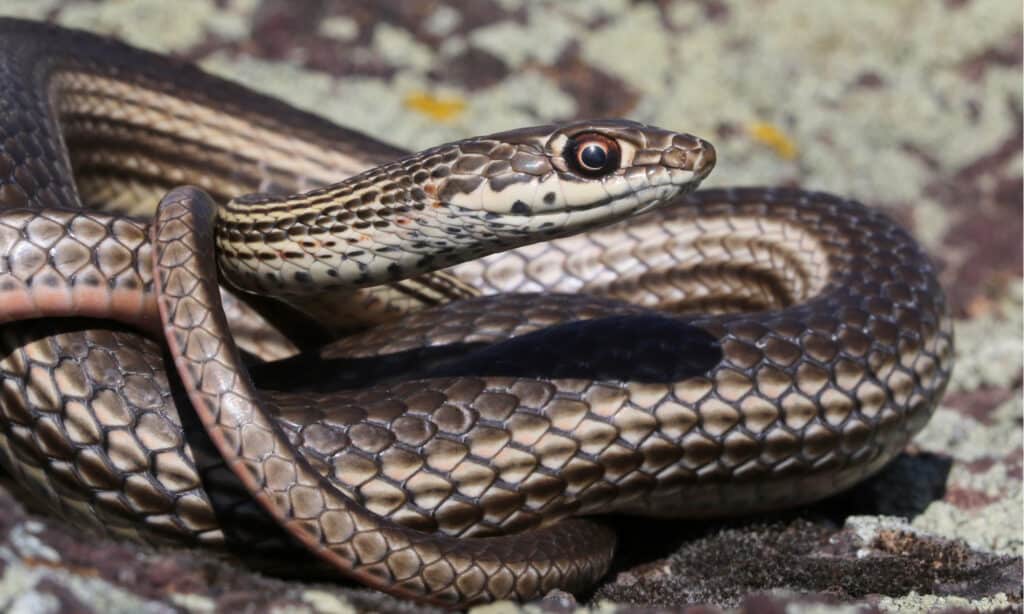
Striped whipsnakes are dark snakes with light stripes down their sides.
©Randy Bjorklund/Shutterstock.com
One of the largest snakes in Nevada is the striped whipsnake which is between 2.5 and 6 feet long. Striped whipsnakes are typically black, gray, brown, or blueish green with two lighter stripes along each side. They live in various habitats, such as grasslands, shrublands, and woodlands. However, in Nevada, they usually inhabit the woodlands around Lake Tahoe. Striped whipsnakes are not venomous and prey on rodents, lizards, birds, frogs, and other snakes (including venomous ones). They are active during the day and rely heavily on their keen eyesight to spot prey.
Desert Tortoise
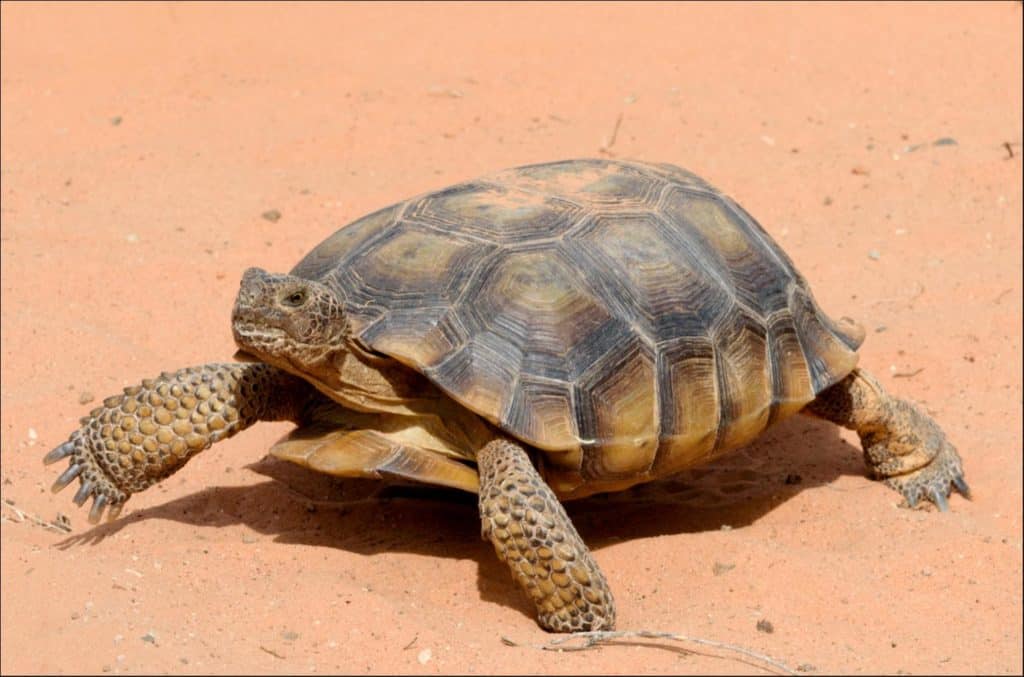
Desert tortoises live in the Mojave Desert, where they shelter from the heat in burrows.
©John Andrus/Shutterstock.com
The desert tortoise is generally considered one of the largest reptiles in Nevada, reaching 10 to 14 inches long. As their name suggests, desert tortoises live in deserts – usually across the southwestern region of the US and the northwestern region of Mexico. In Nevada, desert tortoises are native to the Mojave Desert, where they heavily rely on burrows for shelter from the intense heat. Desert tortoises are a keystone species as the burrows they make are used (and relied upon) by many other animals – from insects to burrowing owls to Gila monsters.
Moose

Weighing 1,500 pounds, moose are the largest animals in Nevada.
©iStock.com/pum_eva
The largest animal in Nevada is the moose, the largest deer species. Moose are some of the most impressive animals with their huge, broad antlers. Moose can stand more than 7 feet tall at the shoulder and weigh up to a staggering 1,500 pounds. Although they were long thought to be absent from Nevada, there has been a significant increase in the number of sightings of them within the state. Moose typically prefer to live in forests and on grassy slopes, but any area with sufficient plants and trees for them to eat suits. In Nevada, the areas with the most confirmed sightings of moose are Elko and Humboldt counties.
Summary of the 10 Largest Animals in Nevada
| Name of Animal | Size | Habitat |
|---|---|---|
| Golden Eagle | 5.9-7.5 foot wingspan | Grasslands, hillsides, and mountain regions. |
| Flame Skinner | 2-3 inches long | Around ponds, streams, and gardens. |
| Gila Monster | up to 22 inches long | Deserts and grasslands. |
| American Black Bear | 150-660 lbs. | Thick vegetation in woodlands and mountains. |
| Desert Tarantula | 4″ leg span | Desert burrows. |
| Largemouth Bass | 29.5 inches long; up to 25 lbs. | Freshwater lakes. |
| Mustang | 800 lbs. | Widespread, but often in mountainous regions. |
| Striped Whipsnake | 2.5-6 inches long | Mostly the woodlands around Lake Tahoe. |
| Desert Tortoise | 10-14 inches long | Mojave Desert burrows. |
| Moose | 7 feet tall at shoulder; up to 1,500 lbs. | Prefer forests and on grassy slopes. |
The photo featured at the top of this post is © BGSmith/Shutterstock.com
Thank you for reading! Have some feedback for us? Contact the AZ Animals editorial team.






